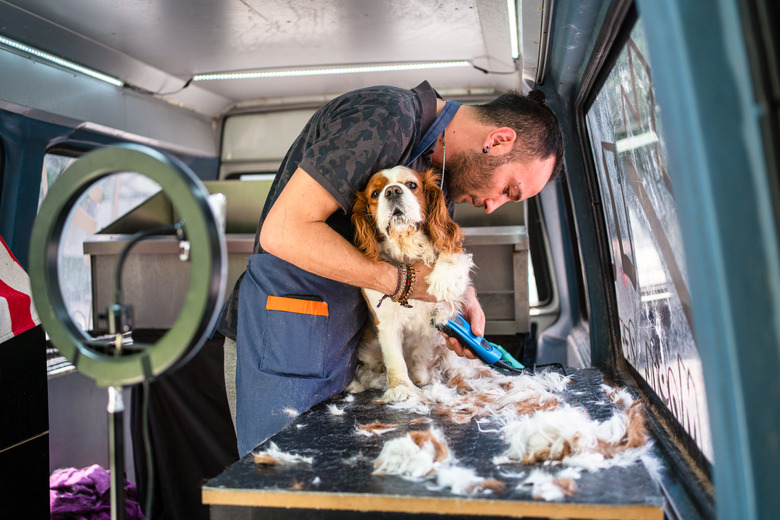9 Tips For Minimizing Pet Dander
Pet dander consists of tiny skin particles shed by animals with fur or feathers, such as cats, dogs, birds, and rodents. Pet dander is a common allergen, but there are many things you can do to reduce pet dander in your home, such as cleaning your home often, creating allergy-free zones, bathing your pet, and using HEPA filters. When you can reduce the amount of pet dander in your home, you'll be able to reduce your allergy symptoms as well.
1. Clean your home often
1. Clean your home often
One method of reducing pet dander in your home is to clean on a regular basis. Vacuum carpets and use a lint roller on fabric surfaces to remove pet dander. Use a steam cleaner on carpets and hard floor surfaces to clean deep down. Regularly wash furniture covers, curtains, bedding, and pet beds.
2. Declutter your space
2. Declutter your space
Pet dander sticks to all types of surfaces. Reducing how much stuff you have in areas of the house in which your pet is allowed gives pet dander fewer things to cling to and fewer places to hide. In addition, decluttering makes cleaning your floors and walls easier.
3. Create allergy-free zones
3. Create allergy-free zones
Restrict your pet's access to a specific area or areas of your home. Ideally, your allergy-free zone should be your bedroom, but if this isn't possible, clean your bedroom often and use a HEPA filter to help minimize cat dander and dog dander.
4. Reduce protein-causing allergens
4. Reduce protein-causing allergens
Purina makes a food in its Pro Plan line for cats called LiveClear that helps reduce protein-causing allergens. All cats produce a protein known as Fel d 1. Fel d 1 causes reactions in 95 percent of individuals who are allergic to cat dander. Fel d 1 is produced in the sebaceous and salivary glands in cats, and it is transferred to a cat's skin and fur when she grooms herself. The protein is then released into the environment as cat dander when your cat sheds.
Pro Plan LiveClear is formulated with a protein sourced from eggs that contains an antibody for Fel d 1. When you feed the LiveClear diet to your cat, it decreases the amount of Fel d 1 that's produced in your cat's saliva. Therefore, less of this protein is transferred to your cat's body when she grooms, and less of the protein enters the environment in your cat's dander when she sheds, which may minimize your allergy symptoms.
5. Bathe your pet weekly
5. Bathe your pet weekly
For dander control for dogs and cats, you can bathe your pet once a week. Bathing gets rid of the dander on your pet's fur so that it isn't shed into the environment. It's best if you can start this practice when your pet is young to get him acclimated to the process. Use products specifically labeled for your type of pet, such as cat shampoo for your cat or dog shampoo for your dog. Ask your veterinarian for recommendations for grooming products for your pet.
6. Brush your pet to reduce pet dander in your home
6. Brush your pet to reduce pet dander in your home
Brushing your pet helps remove dead skin from your pet's body, which means less of it is shed into the environment. Brushing your pet can also help you strengthen your bond with your dog or cat. The frequency of brushing will depend on the length of your pet's fur. Long-haired cats and dogs need to be brushed daily, while a cat or dog with short hair can be brushed once each week.
7. Use a HEPA filter
7. Use a HEPA filter
High-efficiency particulate air (HEPA) filters are effective at removing dust, mold spores, bacteria, pollen, and pet dander from the air. HEPA filters are so effective that they remove 99.97 percent of air particles 0.3 microns or larger. If you don't have a whole-house HEPA filtration system, you can get air purifiers containing HEPA filters. Many vacuums also contain HEPA filters. It's important to note that while HEPA filters are effective for cleaning the air in your home, they won't remove pet dander from surfaces, such as walls, floors, furniture, and bedding.
Remember to change your HEPA filters regularly. Additionally, you should hire a professional to clean your air ducts periodically. Professionals have the right equipment to thoroughly clean your air ducts without redistributing the dust, pet dander, mold spores, bacteria, and other debris into the air.
8. Replace HVAC filters regularly
8. Replace HVAC filters regularly
If you have an HVAC system in your home, it's important to replace the filters on a regular basis. When an HVAC system is clogged, some of the debris that is removed from the air can find its way back into the environment. Ask a professional how often you should replace your HVAC filter. You may need to replace the filter more often if you have multiple pets in your home.
9. Use hard flooring materials
9. Use hard flooring materials
Pet dander sticks to soft surfaces more easily than it does hard ones. If it's possible, remove the carpeting in your home and invest in hard flooring materials instead. You can consider linoleum, vinyl, or hardwood for your flooring.
